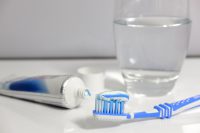Read on for our top tips on toothpaste essentials.
If you brush your teeth well, you don’t need any extra ingredients other than Fluoride. Fluoride helps control tooth decay by reducing the effect of acid erosion.
Look back at our previous Blog on Fluoride for all you need to know. 1st Feb 2018

However adding toothpaste to your brush does enhance the experience, if only by adding moisture and breath freshening agents.
There are other ingredients beside Fluoride with proven oral health benefits.
- Triclosan is antibacterial
- Arginine neutralises plaque acids
- Silica is abrasive, so can remove surface stains
- PVM/MA Copolymer is a binder, when added to ingredients such as Triclosan, helps it stay on your teeth and gums
- SLS Sodium Lauryl Sulfate is a foaming detergent which dissolves dirt and grease
Toothpaste manufacture is a competitive industry and all sorts of claims are made. Big name brands can be more expensive but don’t be too misled, you need to compare prices per 100ml.
If you pay more, do you get a more effective product for your money?
Generally bigger companies can afford more extensive or better quality research for evidence of effectiveness.

Your oral health comes down to your own daily hygiene regime alongside regular visits to your Dentist and Hygienist and tooth brushing is an important part of this but we are all individuals and our teeth and gums can be affected differently by common factors such as our general health, environmental influences or lifestyle.
Because of this toothpaste manufacturers create products to target specific needs.
Sensitivity – the key ingredient is potassium nitrate but there is little evidence that specific toothpastes targeted at reducing sensitivity are any better than reducing acidic foods and drinks in your diet or avoiding brushing after eating.
Wait at least 30 minutes after eating before you brush.
Tooth enamel is a protective layer for your teeth. Acids created by the breakdown of food can wear away that protective enamel. During meals, the acid level is raised and your teeth are at their weakest state.
Saliva works to restore the proper pH level and wash away acidic food particles, giving your enamel the balance it needs to continue its protective work.
Even soft-bristled toothbrushes can be highly abrasive when enamel is weakened by high acid levels. It’s best to let saliva do its job first after you eat.
Another common cause of sensitivity is over-brushing or being too enthusiastic with your toothbrush. Ask your Hygienist to show you the best way to brush.
Avoid toothpastes that contain abrasive ingredients, often those claiming to whiten teeth or remove stains.
Whitening – there is limited evidence of whitening toothpastes having an advantage over standard fluoride toothpaste and in no way can they compete with the effectiveness of professional whitening.
How do they whiten? Colgate adds optical brighteners, a blue pigment that leaves a sheen on your teeth temporarily. Other types contain abrasives such as silica. Beware fads such as charcoal based toothpastes, these can be strongly abrasive but often don’t contain fluoride, so fail to protect your teeth from decay. There is no substantiated evidence for the benefits of charcoal.

Enamel erosion protection – claims like strengthens, restores enamel or prevents erosion are backed up by limited evidence that there is a significant advantage over standard toothpaste.
Again take note of dietary and brushing advice above for effective enamel protection.

So when it comes to choosing a toothpaste look at what is in it and don’t be swayed by the hype that goes with it! Make a good choice based on Fluoride content, antibacterial properties and taste and ask your Dentist for their recommendation.
Don’t forget your empty toothpaste tubes are recyclable through the Colgate/Terracycle initiative, for which we are a collection point.
And hot off the press! Colgate have also just started manufacturing recyclable toothpaste tubes.

